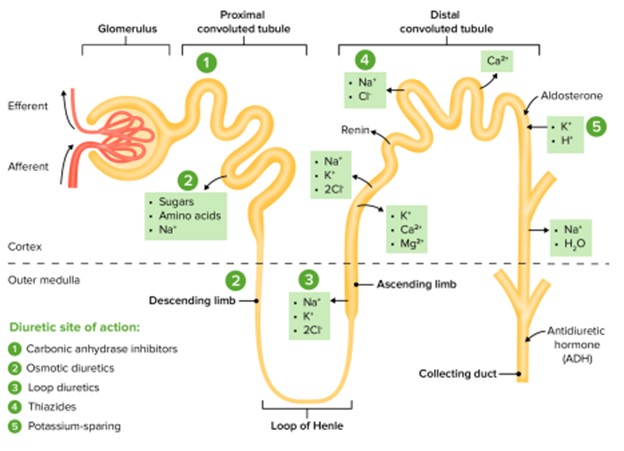Which manifestations would the nurse expect for a client with a history of malignant hyperthermia (MH)?
Select all that apply.
Dysrhythmias
Hypertension
Muscle rigidity of jaw and upper chest
Tachypnea
Skin mottling
High body temperature
Correct Answer : A,C,D,F
Muscle rigidity is a hallmark sign of malignant hyperthermia. It commonly affects the muscles of the jaw and upper chest.
Malignant hyperthermia can lead to rapid and shallow breathing, resulting in tachypnea. Malignant hyperthermia is characterized by a significant increase in body temperature, often exceeding 38.8°C (101.8°F).
Malignant hyperthermia can cause irregular heart rhythms or dysrhythmias, including tachycardia or arrhythmias.
The manifestations of hypertension and skin mottling are not typically associated with malignant hyperthermia. Hypertension (high blood pressure) is more commonly seen in conditions such as hypertensive emergencies or certain cardiovascular disorders. Skin mottling, which refers to irregular or patchy skin coloration, is not a specific manifestation of malignant hyperthermia.

Nursing Test Bank
Naxlex Comprehensive Predictor Exams
Related Questions
Correct Answer is C
Explanation
Loop diuretics, such as furosemide, are known to promote diuresis (increased urine output) and can cause electrolyte imbalances, including low potassium (hypokalemia). The patient's statement about eating a diet rich in potassium-containing foods like potatoes, bananas, avocadoes, strawberries, and spinach is incorrect in this context. These foods are indeed good sources of potassium, but when taking loop diuretics, it is necessary to monitor and potentially restrict potassium intake to prevent excessive potassium levels.
"I will weigh myself daily and report to my physician if I gain more than 3 lbs in 1 day." This statement reflects the patient's understanding of the need to monitor their weight daily as a means of assessing fluid balance. Rapid weight gain may indicate fluid retention, which should be reported to the physician.
"This medication can cause dehydration, so I will stay hydrated by consuming at least 2 L or more of fluid per day." This statement demonstrates awareness of the potential for dehydration when taking loop diuretics and the importance of staying adequately hydrated by consuming an appropriate amount of fluids.
"I will change position slowly because I can become dizzy easily while taking this medication." This statement reflects the understanding that loop diuretics can cause orthostatic hypotension,
leading to dizziness upon sudden changes in position. Taking precautions and changing position slowly can help prevent falls and related injuries.

Correct Answer is ["A","B","C","D","E"]
Explanation
a. Considered primary treatment for small cell lung cancer (SCLC): Chemotherapy b. Used to prevent metastasis to the brain: Prophylactic cranial radiation
c. Electric current heats and destroys tumor cells: Radiofrequency ablation d. Best procedure for cure of lung cancer: Surgery
e. Medications that block molecules involved in tumor: Biologic and targeted
Whether you are a student looking to ace your exams or a practicing nurse seeking to enhance your expertise , our nursing education contents will empower you with the confidence and competence to make a difference in the lives of patients and become a respected leader in the healthcare field.
Visit Naxlex, invest in your future and unlock endless possibilities with our unparalleled nursing education contents today
Report Wrong Answer on the Current Question
Do you disagree with the answer? If yes, what is your expected answer? Explain.
Kindly be descriptive with the issue you are facing.
